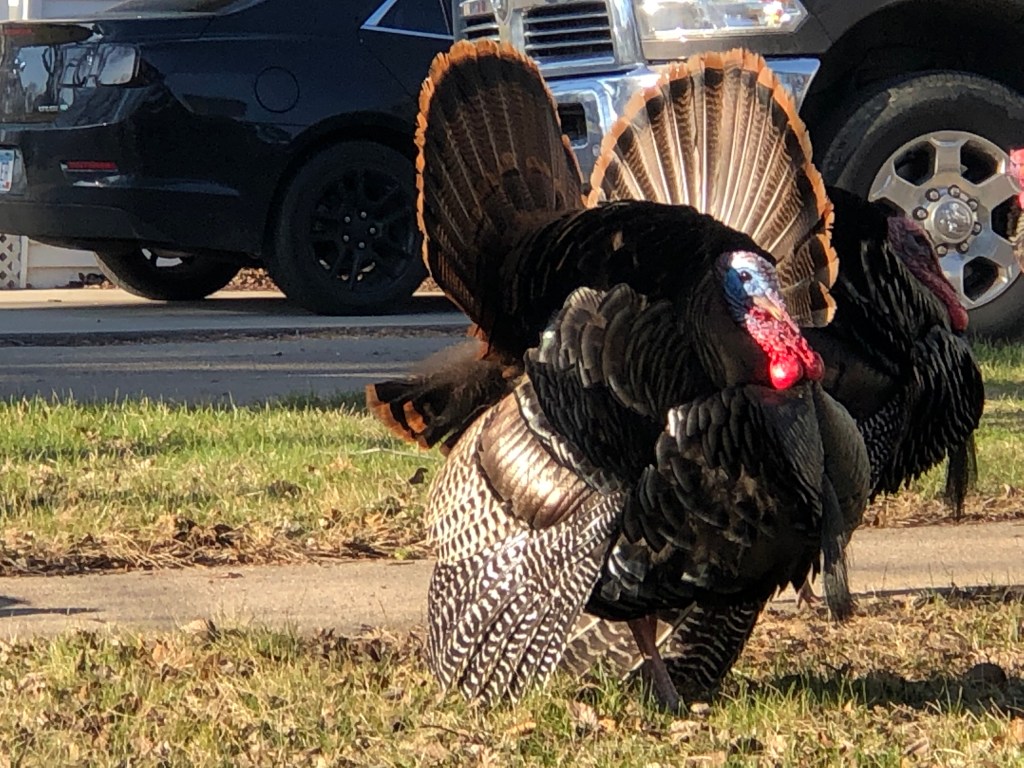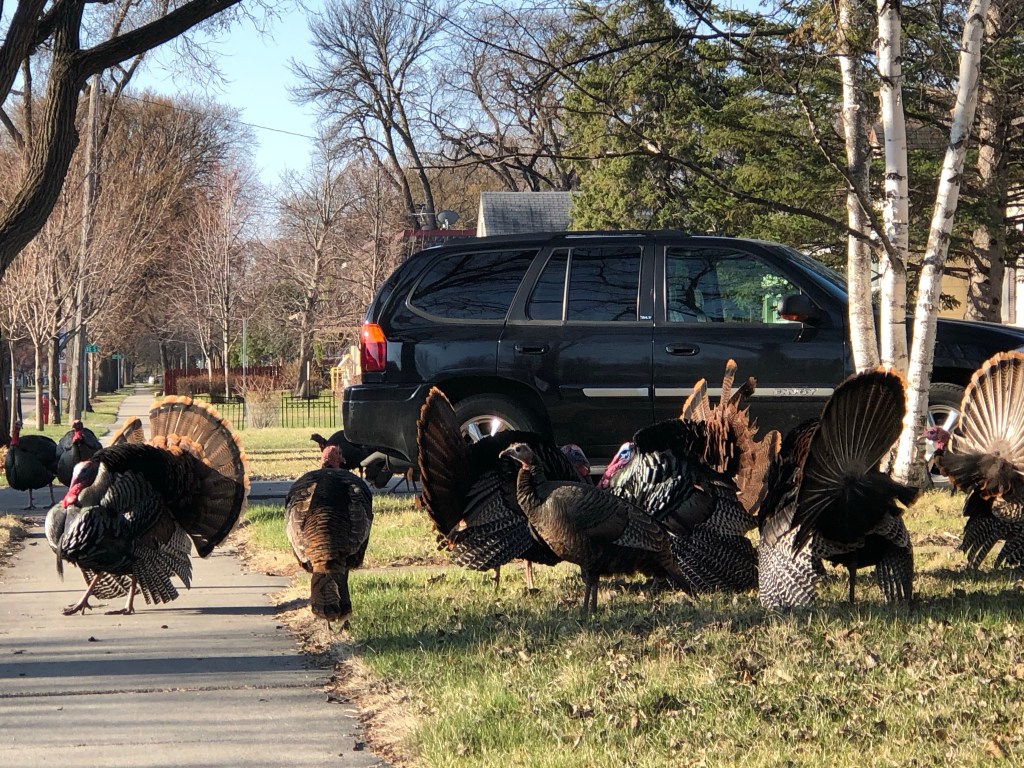We can hardly take our eyes off the turkeys.
Every time we see them strut and dance through our yard, which happens multiple times a day now, my son and I call out “Turkey Time!” and turn our attention to the male birds that transform themselves from red-headed, mostly dun-colored commoners into flashy samurai warrior-birds: chests puffing, tails fanning, wings rounding and lowering, feather fingers dragging through the slowly emerging blades of grass, faces vacillating red and blue.
The texture of their body feathers changes between one of overbred roses—layers and layers of thin, wavy petals—to that of lacquerware buffed to a high gloss, so deep and dark as to appear polished with oil. And then, in a flash, something happens, and they devolve into their unassuming dull selves.
Unexpectedly, these birds take me on an imaginary vacation. With their measured, stylized movements, they remind me of the kabuki actors I watched in Tokyo, men in elaborate kimono gliding before luminous gold screens, singing, acting and dancing hundreds-year-old stories, tracing long-ago-choreographed movements with their feet, their fan- and sword-holding hands, their chins and noses.
I remember sitting in the audience mesmerized, having just flown in (rather bedraggled) after four months in India. I had landed in Tokyo in the evening with no plans and nowhere to stay (I had been unable to get a phone line before catching my flight from Madras, now Chennai), so I called a friend who had been an exchange student at my high school, and, thankfully, his family insisted I stay with them.
My friend had no sisters, so his mother quickly devised a girls’ day out. She sent me to get my hair washed and styled to her specifications (what I would term semi-bouffant), and announced that the two of us would attend the December kabuki performances.
I cringe to think what wrinkled item I pulled from my duffel bag to wear. Meanwhile, she wrapped herself in an elegant wool kimono, black designs framed in diamonds on a gray background, belted with a vermillion-colored obi. Over this she added a wrapped coat woven in many shades of red. The overall effect was muted but striking.
I was barely past jet lag when we arrived at the historic Kabuki-za performance hall, which was built in 1889. Along with hundreds of other kimonoed women, we spilled into soft chairs facing a stage draped with a sumptuous curtain of metallic gold and red. When at last it was swept aside, fantastic sets and elaborately costumed actors transported us back to Tokugawa-era Japan (1603-1868), the days when kabuki got its start.
We watched as the daimyo Tsuchiya Chikara looked out his sitting room window, framed by painted pine trees, watching a peaceful snowfall, white paper floating down from an imaginary sky, covering the stage in a dusting of flakes. We heard the prostitute Otsuta call out to a bullied, down-on-his-luck aspiring sumo wrestler from her second-floor balcony. Scene after scene brought us back in time as these actors moved and spoke with control and grace, the female parts warbling like a bird.
Although I knew that kabuki was the domain of male actors, those in female roles were so convincingly feminine I could not help but ask my host, “Are they really men?” And again, “Really?” Later I would read how the men who specialized as onnagata—actors playing the role of women—created the illusion of femininity: twisting their arms to make them appear shorter and delicate; bending backwards to create a bust; pressing their legs together to appear slender; keeping their hips low and knees slightly bent to create an artificial hourglass figure. I learned that in the Tokugawa era they modeled their characters on popular courtesans, watching how they acted, what they said and what they wore.
I was utterly transfixed—by who these men were and by who they weren’t—and by the otherworldliness of the entire experience.
Today, decades later, we all are living in the alternate reality of a pandemic and such memories seem as if they happened in a dream. We have no hope of a Kabuki-za outing anytime soon, not even local community theater, no dropping in on friends in far-off—or nearby—lands.
But, thankfully, we do have our turkeys, with their stylish plumage and grand dances. And we have this opportunity to develop an appreciation of what we have right here in our own back yard.








Sarah, GREAT article. As I got into it I thought, I bet she’s going to go full circle with this — and she did. Great writing. You even got 4 months of India in there. I just passed it along to another Ole, class of ’79, who is an ardent turkey hunter and also an Itasca winter ecology grad – one of the beaver boys. Keep up the good work. Gene
>
Thank you so much, Gene! Those four months in India show up with amazing regularity, don’t they? 🙂 I’ll be posting another turkey story in the next few days … lots happening on the local turkey front!
Just some thoughts—-
This was a great read and I had no idea turkeys could be so interesting. While gazing, I noticed a word on the car between two turkey’s’ tail feathers. After reading with a magnifying glass, it turned out to be ENVOY, a messenger who is a ranking member of the diplomatic corp. Hmmm, my mind went out and away.– turkeys as messengers , as diplomats. bringing the message. Here, it is one of beauty, pomposity, and like the Kabuki actors, a combination of male and female to challenge our imaginations and assumptions.
They are wild which means they are unpredictable, not like a diplomatic messenger but marching along to their own drummers as they strut and entertain the crowd. Their colors are regal and their plumage an exploding array of feathers.
They seem to bring joy to everyone who takes the time to watch them as do the Kabuki performers. I wish we could bring them all together.
Carolann
Carolann, I love the directions your imagination took you! Maybe these turkeys are envoys, welcoming us back to Minnesota … much as it seemed the kabuki actors were part of my welcome to Japan. I can only imagine the spectacle if we put these regal turkeys and talented kabuki performers on the same stage!